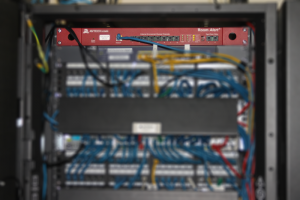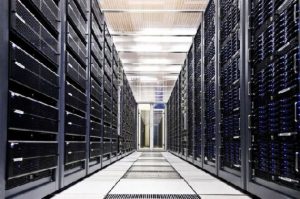
Knowledge Base / News / IT & Data Centers
Data centers are heavily guarded against intrusion and network data loss. Cyber-attacks and cybercrime remain among the top reasons for data center outages, and data center owners as well as businesses that operate their own data center have multiple safeguards in place to protect them.
Unplanned data center outages come from many sources, however. Environment issues account for almost 30% of all unexpected downtime, with UPS failure leading the way, closely followed by temperature issues and HVAC failure. It’s crucial to monitor environment factors such as temperature, humidity, flood, power, smoke, and more than can cause costly downtime.
To increase reliability and uptime, here are three key reasons why you should monitor the environment of your data center.
 Data center outage costs are escalating
Data center outage costs are escalatingSince 2010, downtime costs in data centers have risen by 38%. Internet technology growth has skyrocketed, as has the use of cloud services over the past few years.
With the average cost of a data center outage at almost $750,000, it’s vitally important to make sure every safeguard is in place against that type of loss. Lost revenue and productivity will bring any business to a screeching halt, and that type of loss can even cause an SMB to close its doors. Being alerted to a power outage due to uninterruptable power supply (or generator) failure, or notification of rising temperatures indicating a failing HVAC unit, can help prevent costly downtime.
If your company offers services online such as Software as a Service (SaaS) or any other cloud-based platform, any data center outage you suffer will cost you dearly. Customers are moving their services to the cloud at a rate of 19.4% annually, which means more revenue for data center operators, and also a much higher rate of revenue loss if/when you suffer an outage.
No matter how well you plan, the unexpected can and will happen. The average length of a data center outage is 90 minutes and there’s simply no way to fully prepare for, or expect, a weather or HVAC-related outage unless you’re specifically monitoring the environment. For instance, gradually rising temperatures or relative humidity can help pinpoint HVAC units that are about to fail or need servicing.
While no one can control the weather, a data center can be warned the very moment water is detected due to heavy rains or melting snow. Helping to stop the spread of water can help protect equipment and personnel, leading to less downtime and potential staff injuries due to slip and fall incidents.
 Businesses who don’t have their own local infrastructure to support a data center will often colocate their servers in a multi-tenant facility. This allows them to take advantage of the data center’s power, bandwidth, and cooling at a much lower overall cost than building their own data center.
Businesses who don’t have their own local infrastructure to support a data center will often colocate their servers in a multi-tenant facility. This allows them to take advantage of the data center’s power, bandwidth, and cooling at a much lower overall cost than building their own data center.
However, when an organization relies on another data center’s infrastructure, they’re also relying on their network and environment monitoring. Data center customers in these instances can easily and inexpensively add environment monitors to their equipment to help monitor factors like temperature and humidity. While a data center will often monitor bandwidth use and provide colocated customers with traffic statistics and graphs, they very rarely do the same with temperature, humidity, and power.
Data center customers who colocate should be monitoring for temperature spikes, humidity changes, or power issues, all of which can cause downtime for their servers if not the entire data center. Even if it’s not right away, higher or lower temperatures in addition to humidity outside the normal range can lead to eventual equipment and hard drive failure. By monitoring the environment around your colocated servers, you can be notified immediately of a problem that your data center may not be monitoring on your behalf.
In today’s digital economy, revenues are directly tied into services being offered and used online. If your customers can’t get to their service due to a data center outage, your revenues will suffer. Protect your company by making sure your data and infrastructure is secured from both cybercrime and environmental threats by implementing both data security as well as environment monitoring in your data center.
If you have questions about the different types of environment monitors and sensors available that can help protect your data center, please let us know! Our Product Specialists are experienced in helping put together customized monitoring plans and packages to help businesses of all types and sizes. Contact us today at 401.628.1600, toll free 888.220.6700, or via email Sales@AVTECH.com. Don’t delay! Always remember, ‘Proactive Monitoring’ is better than ‘Disaster Recovery’.

You may find Windows Command Prompt at the following path:
To run Windows Command Prompt as an administrator:
| Current S models | Current E models |
|---|---|
| Room Alert 32S | Room Alert 32E |
| Room Alert 12S | Room Alert 12E |
| Room Alert 3S | Room Alert 4E |
| Room Alert 3E | |
| S models | E & W models |
|---|---|
| Room Alert 32S | Room Alert 32E |
| Room Alert 12S | Room Alert 12E |
| Room Alert 3S | Room Alert 4E |
| Room Alert 3E | |
| Room Alert 3W |
| Model |
|---|
| Room Alert MAX |
| Room Alert 32S |
| Room Alert 12S |
| Room Alert 3S |
| Room Alert 32E/W |
| Room Alert 12E |
| Room Alert 4E |
| Room Alert 3E |
| Room Alert 3 Wi-Fi |